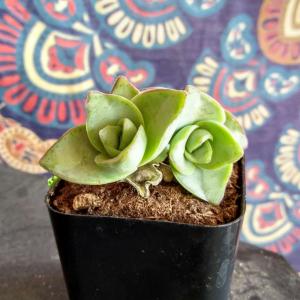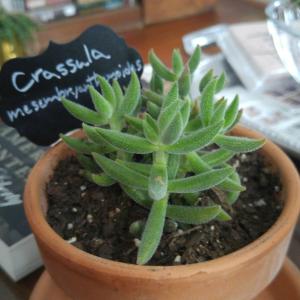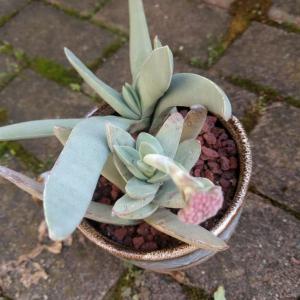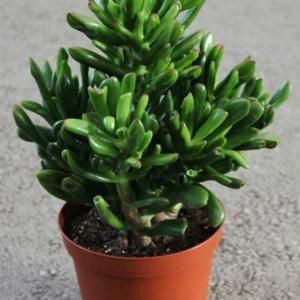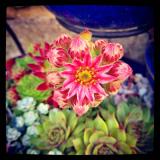文章
Miss Chen
2017年08月08日


Jade plants (Crassula ovata) can be grown from a single leaf and end up over 5 feet tall. They have fleshy branches and rounded, glossy leaves. As succulents, they require little water but grow best in bright light with some direct sunshine. Jade plants lose older leaves naturally but an increase in the rate of leaf loss is often the first sign of a problem.
Underwatering
Jade plants that are not receiving enough water often shed their older leaves. If the lower leaves on your plant are shriveling up and then falling off, check its soil. If it is completely dry, water your plant thoroughly. Water a jade plant every time the top inch of its soil is completely dry. Jade plants add leaves and shoots during the summer and need more water during the hot summer months.
Overwatering
Succulent jade plants are vulnerable to rot and must never be left with their pot standing in water. Check your plant's soil if its leaves turn yellow and start to drop off. Do not apply any more water until it has dried out completely. Remove the plant from its pot if you notice any soft sections on the trunk or branches. Wash all the soil off the roots and place it on a windowsill for a week. Cut off any branches or roots that are soft and repot in cactus potting mix.
Light
If your jade is losing its lower leaves at the beginning of winter this is likely to be because of low light. Move your plant closer to a window to increase light levels. Jade plants that are kept close to a window will shed leaves if they touch the glass on very hot or very cold days. Keep the plant a few inches back from the glass.
Temperature
Keep jade plants above 50 degrees Fahrenheit during the winter as cold temperatures will damage the leaves. Frost will kill your jade plant completely. Jade plants will shed leaves if they are placed in a cold draft or close to a radiator. A sudden change in temperature caused by a move will also cause leaf drop. The leaves will grow back once your plant has adapted to its new surroundings.

Leaf Shine
Never use leaf shine products on jade plants as it will cause all their leaves to turn yellow and fall off. Household chemicals and cleaners have a similar effect if they touch the leaves. Jade plant leaves shine naturally if they are dust free and the plant is healthy.
Pests
Jade plants are vulnerable to infestations of mealy bugs and scale insect. Mealies and scale make jade leaves sticky and can encourage the growth of molds. They also cause leaf drop and deformed leaves. Treat mealies and scale by dabbing them with a paintbrush dipped in a 70 percent solution of rubbing alcohol.
0
0
文章
Miss Chen
2017年08月08日


Miniature pine tree (Crassula tetragona) is a low-growing succulent shrub resembling a small pine tree, boasting a tree-like habit of bluish green, awl-shaped leaves and spring-blooming white flowers. A popular bonsai, miniature pine tree is often grown as a potted garden plant or houseplant, though it may also be grown directly in the garden where hardy. Aesthetically, miniature pine tree fits in well with rock gardens, bonsai plantings and zen-themed gardens.
Location
A native of South Africa, miniature pine tree is a heat-loving frost-sensitive plant, hardy to about 28 degrees Fahrenheit. It may be grown successfully outdoors in U.S. Department of Agriculture plant hardiness zones 9 to 11, where it will thrive in full sunlight or light shade. Provide indoor plants a winter dormancy period with temperatures around 48 degrees Fahrenheit.
Soil
Like other succulents, miniature pine tree requires very well draining soil. Poorly draining soil, coupled with excessive irrigation, is a surefire recipe for the often fatal fungal disease root rot. A mixture of sand, loam, pea gravel and peat moss with a pH between 6.1 and 7.8 is ideal. Fertilize once during the growing season with a balanced 10-10-10 fertilizer diluted with water to about half strength.

Maintenance
The low maintenance miniature pine tree requires water only once a month or so during the growing season, watering deeply, then allowing the soil to completely dry out before watering again. In the winter, water sparingly, just enough to keep the leaves from shriveling. Miniature pine tree may be propagated by leaf or stem cuttings, rooted in moist, well-draining potting media. The plant may also be divided during the growing season or grown by seed.
Problems
Members of the Crassula genus are prone to mealybugs -- small, cottony insects that form colonies on leaves. If left unchecked, they may stunt plant growth or invite unattractive black sooty mold. The University of California Integrated Pest Management Program recommends removing mealy bugs with a direct stream of water or applying insecticidal soap or narrow-range oil. Avoid excessive use of insecticides in the home garden, which can kill the beneficial insects and parasites that prey on mealybugs.
1
1
文章
Dummer. ゛☀
2017年08月06日

BOTANICAL NAME:
Crassula argentea, Crassula ovata
PLANT TYPE: Houseplant
SUN EXPOSURE: Part Sun
With its thick, woody stems and oval-shaped leaves, jade plants have a miniature tree-like appearance that is very appealing. They live a very long time, often reaching heights of three feet or more when grown indoors.
Though jade plants like the warm, dry conditions found in most homes, they are not as drought tolerant as other succulent species. It’s important to keep the soil moist (but never damp).
PLANTING
Plant in a sturdy container with an all-purpose soil blend. Use a soil that will drain thoroughly, as excessive moisture may promote root rot.
A cactus mix with some organic matter will do. You can also make a mix of one part sterilized organic soil, one part sphagnum peat moss, and three parts coarse sand by volume
Jade plants are known to have very thick stems and may eventually become top-heavy, so plan ahead by planting in a wide and sturdy pot.
CARE
Place jade do need 4 or more hours of sunlight each day; kitchens and offices with a south-facing window are typically great spots with just enough light.
Jade plants grow best at room temperature (65 to 75°F), but prefer slightly cooler temperatures at night and in the winter (55°F).
Keep soil moist but not wet during active growth in the spring and summer. Allow soil to dry between waterings in the winter. Avoid splashing water on the leaves while watering.
If shedding or brown spots occur on the leaves, it is an indication that the plant needs more water.
Jade plants may be fertilized three to four times a year with a standard liquid houseplant fertilizer.
During the winter months, move the plants away from cold windowpanes and out of drafts.
Jade plants do not mind being root-bound. If the plant gets top-heavy and you need to move to a larger pot, transplant when new growth starts. Let the soil dry before repotting and wait four months before fertilizing any repotted plants.
PESTS/DISEASES
Mealybugs may hide under stems and leaves. To remove the bugs, use a spray bottle of water or wipe the insects off gently with a bit of rubbing alcohol on a paper towel or cotton swab.
Powdery mildew is a common problem.
Root rot is due to excessive moisture in the soil.
Leaf drop is a sign of a thirsty plant in need of more frequent watering.
Crassula argentea, Crassula ovata
PLANT TYPE: Houseplant
SUN EXPOSURE: Part Sun
With its thick, woody stems and oval-shaped leaves, jade plants have a miniature tree-like appearance that is very appealing. They live a very long time, often reaching heights of three feet or more when grown indoors.
Though jade plants like the warm, dry conditions found in most homes, they are not as drought tolerant as other succulent species. It’s important to keep the soil moist (but never damp).

PLANTING
Plant in a sturdy container with an all-purpose soil blend. Use a soil that will drain thoroughly, as excessive moisture may promote root rot.
A cactus mix with some organic matter will do. You can also make a mix of one part sterilized organic soil, one part sphagnum peat moss, and three parts coarse sand by volume
Jade plants are known to have very thick stems and may eventually become top-heavy, so plan ahead by planting in a wide and sturdy pot.

CARE
Place jade do need 4 or more hours of sunlight each day; kitchens and offices with a south-facing window are typically great spots with just enough light.
Jade plants grow best at room temperature (65 to 75°F), but prefer slightly cooler temperatures at night and in the winter (55°F).
Keep soil moist but not wet during active growth in the spring and summer. Allow soil to dry between waterings in the winter. Avoid splashing water on the leaves while watering.
If shedding or brown spots occur on the leaves, it is an indication that the plant needs more water.
Jade plants may be fertilized three to four times a year with a standard liquid houseplant fertilizer.
During the winter months, move the plants away from cold windowpanes and out of drafts.
Jade plants do not mind being root-bound. If the plant gets top-heavy and you need to move to a larger pot, transplant when new growth starts. Let the soil dry before repotting and wait four months before fertilizing any repotted plants.

PESTS/DISEASES
Mealybugs may hide under stems and leaves. To remove the bugs, use a spray bottle of water or wipe the insects off gently with a bit of rubbing alcohol on a paper towel or cotton swab.
Powdery mildew is a common problem.
Root rot is due to excessive moisture in the soil.
Leaf drop is a sign of a thirsty plant in need of more frequent watering.
4
3
成长记
Nyes
2017年07月29日

I new added a "Crassula" in my "garden"
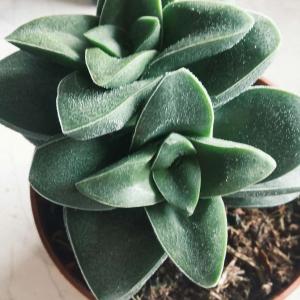

4
0
brielle:lovely!
Ueca:Crassula "Moonglow"



